
You obviously want the experience of towing your caravan to be as safe and predictable as possible. In other words, while towing (particularly at high speed), you want to be confident your caravan is going to ‘tow the line’, both figuratively and literally. As you can imagine, sometimes, when our guests arrive at Horton Common, I get told various stories about their journey. Some of these stories involve caravan instability, such as pitching, swaying or snaking. Now, caravan instability can be caused by various factors (which I’ll discuss below). However, to reduce the frequency of such incidents, I believe it is important that all caravans have some form of stabiliser fitted and its kept in good working order.
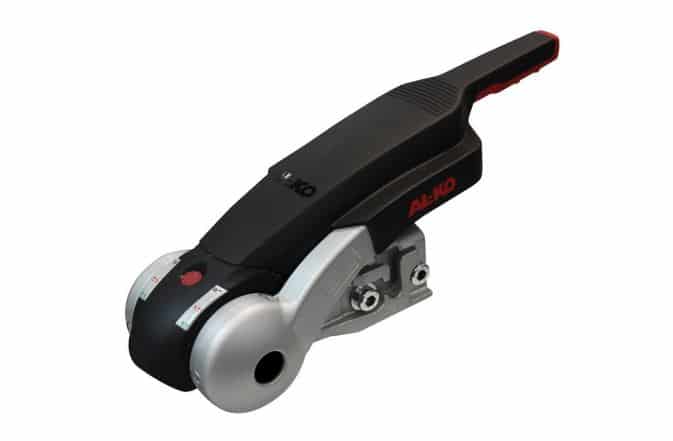
Disclaimer: Hey! By the way… any links on this page that lead to products on Amazon or Caravan Guard are affiliate links, and I earn a commission if you make a purchase, with no additional cost to you 🙂
- Dissolves waste and removes odours naturally and has delightful mild fragrance
So with this post, I wanted to discuss how a caravan stabiliser works, what are the different types and how ‘active’ stabilisation systems are becoming more common.
I hope you learn something new, and if you don’t already have a stabiliser fitted to your caravan, you should seriously consider one.
This is quite a long post, so if you want to jump to any particular section, please use the Table of Contents below.
Want To Visit Horton Common? – Book Here
Table of Contents
Caravan Instability When Towing
So before I discuss what a caravan stabiliser is, how it works, and the different types etc, we need to briefly cover what the different types of caravan instability are.
You will hear people using various terms to describe instability, such as pitching, swaying and snaking, but what do they actually mean?
Caravan Pitching
If your caravan is pitching, it will probably feel like you’re not on the road but a boat on the ocean bobbing up and down.
A common cause of pitching is an incorrect caravan noseweight. Too much weight at the front or back of the caravan, hence its not in balance.
The caravan pitches either side of the axle, putting more and then less force on the car’s tow ball. The speed at which you are travelling can make a difference in how significantly you notice the pitching effect.
Furthermore, caravan pitching is more noticeable on single-axle caravans as opposed to a twin-axle caravans. The reason being on a twin-axle caravan, there is a wider pivot point in contact with the road.
Apparently, fitting caravan shock absorbers can help to reduce the pitching effect. However, currently, very few caravans actually have shock absorbers fitted.
I’ve also not had feedback from our guests as yet who have had shock absorbers fitted.
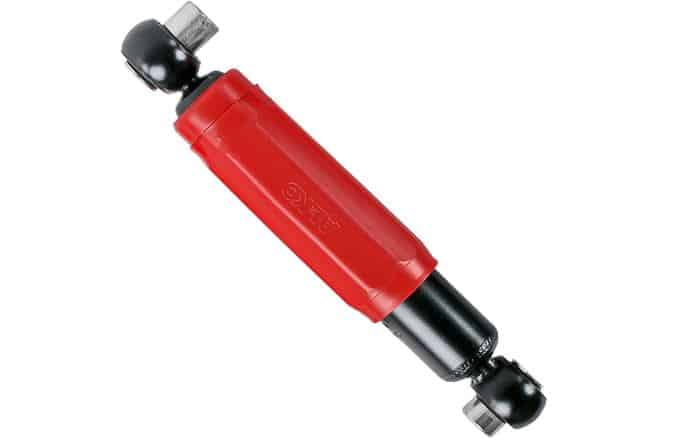
The caravan stabiliser products referenced below can help to reduce issues with pitching. However, they primarily aid in reducing lateral instability (swaying, snaking).
Caravan Sway & Snaking
Caravan ‘snaking’ is pretty much exactly how it sounds. You may also hear snaking referred to as lateral instability.
Due to various factors, at some point, the caravan may become out of line with the car and move side to side.
Proper caravan loading can make a big difference in whether you experience caravan sway/snaking and its severity.
Furthermore, how much your caravan weighs and the relationship between the weight of your car and caravan makes a big impact on caravan lateral instability.
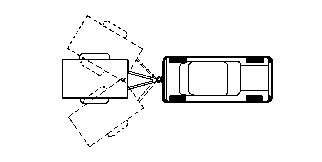
However, even if you keep within the weight limits of your caravan and load it correctly, there are times (potholes/wind gusts) when snaking may still happen.
Therefore, that is where the role of the caravan stabiliser comes in.
To either stop the caravan snaking in the first place or, if the caravan does start to snake, to get you back in control.
There are mechanical caravan stabilisers and active electronic systems of various types, which I’ll discuss below.
What Is A Caravan Stabiliser & How Does It Work?
Above I’ve briefly discussed the types of caravan instability. Now let’s talk about the different types of caravan stabilisers to help address these issues.
The first video I want to reference in this post is from Practical Caravan. This video mainly discusses the types of stabilisers you would find on an older caravan.
However, its still very relevant to the principles of how they all work.
There are two types of caravan stabilisers demonstrated by John in the video above. The first type is commonly referred to as the ‘blade type’.
The second type of caravan stabiliser is part of the hitch head itself. Modern versions are produced by AL-KO, as shown in the image at the start of this post.
Other companies, such as Winterhoff, also produce hitch head stabilisers. There are pros and cons to each type of caravan stabiliser, which I will discuss below.
You may also want to read my post on how to hitch up a caravan.
Blade-Type Caravan Stabilisers
When I was younger, we had an old Mustang caravan which is not in production today.
We had a blade-type stabiliser fitted to the caravan, which I vividly remember as a child, not really understanding what this strange large metal object was for.
A special attachment plate is fitted to both your car’s tow bracket and your caravan’s A-frame.
There is a friction plate in the centre with a spring. The tension can be set to suit the particular caravan’s requirements.
You can still get blade-type caravan stabilisers today, though I must admit I literally haven’t seen a guest turn up with one in years.
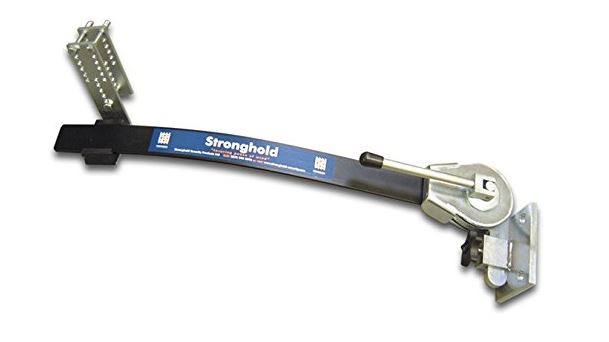
Now, with some modern cars today, you won’t have a tow bracket on the back of your car. Many cars have removable swan neck tow bars.
Well, in these instances, if you want to use a blade-type stabiliser, you’re going to need another product. This is a bracket that clamps around the removal swap neck tow ball to receive the blade-type stabiliser.
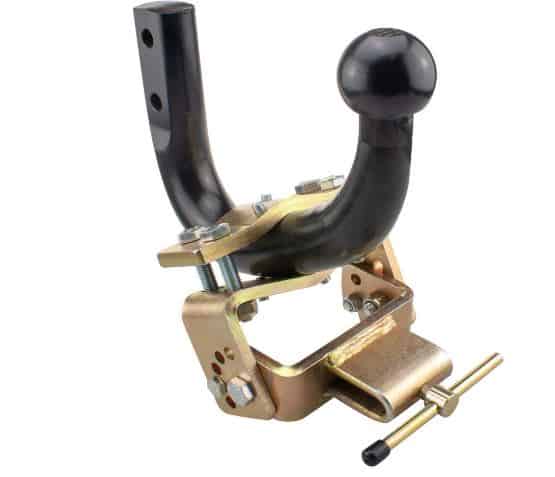
The friction plate in the centre of a blade-type stabiliser provides resistance if the caravan tries to sway side to side and start snaking.
Now, if you have a modern caravan, you will probably already have a hitch head stabiliser fitted, such as those below.
But if you are towing or looking to purchase an older or retro caravan with a standard greased hitch head, I would very much encourage you to consider adding a blade-type caravan stabiliser.
There are obviously pros and cons to this design discussed below:
Blade Type Caravan Stabiliser Pros
- Cheaper than a new hitch head stabiliser.
- Can reduce the pitching and snaking of the caravan.
- Can be transferred between different trailers and caravans.
- May provide more of a stabilising effect than the hitch head type.
Blade Type Caravan Stabiliser Cons
- Quite heavy and bulky.
- Requires new mounting plates fitted to the caravan and car.
Blade Type Caravan Stabiliser Conclusions
You must never drill new holes into your caravan chassis to accommodate any new brackets. Therefore, attaching a mounting plate to the caravan for the blade-type stabiliser might be an issue.
It almost certainly would on a modern caravan. However, as discussed above, the blade type is really only suitable for older ‘retro’ caravans.
However, there are some people, as John referenced in the video, who believe the blade type actually performs better as a stabiliser compared to the hitch head type.
The argument is based on the size of the friction area compared to the small friction pads on hitch head stabilisers which would appear logical.
Though I’ve not got any actual evidence to hand to validate this claim. So its not possible to say which type is better.
What I would say is if you have an older caravan that does not already have a stabiliser hitch head fitted, the blade type is worth considering.
Hitch Head Caravan Stabilisers
In the video above, John shows an old Westfalia caravan stabiliser hitch head he once fitted to his own caravan. Now today, its highly unlikely you’re going to have this type fitted to your caravan.
Its far more likely it will be an AL-KO stabiliser hitch head, as seen in the image at the start of this post, or a hitch head produced by Winterhoff.
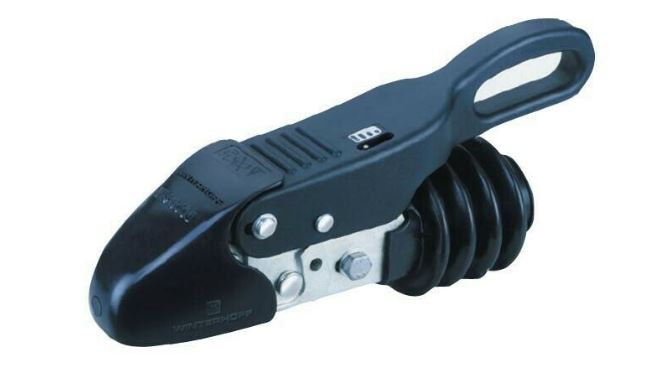
The old Westfalia and the modern AL-KO/Winterhoff stabiliser hitch heads all work on the same principle.
The tow ball clicks into the place, and you then push down the clamp handle, which forces friction pads against the tow ball.
Typically, this will be two friction pads on either side of the tow ball. However, there are now stabiliser hitch heads with additional pads to grip the front/back of the tow ball. This can help to reduce pitching.
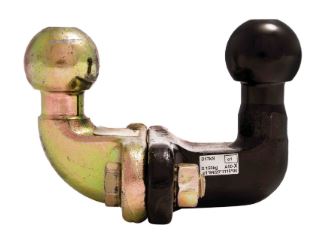
How to Replace Stabiliser Hitch Head Friction Pads
As you can imagine, if the hitch head stabiliser is providing resistance to reduce the chances of snaking etc, its friction pads will eventually wear out.
There are a couple of signs which may indicate your friction pads need replacing. For instance, if you now find it a lot easier to push down the clamp handle, that’s a good sign that pads are worn.
Furthermore, during transit, you may hear various strange noises coming from the hitch head.
Again, at that point, you’ll probably want to get the friction pads off to have a look at them and check their condition.
Before you attempt to change your friction pads, its probably worth checking out Dan’s video below:
In the video, Dan does discuss how to recondition the existing friction pads as opposed to just swapping them out for new ones. This is obviously a personal choice, but do consider their state of wear.
If you do think the clamp handle is going down much more easily than before, just swap the old for new.
However, if the issue was grease/dirt on the friction pad, giving them a clean and putting them back in is an option. Remember to purchase the right friction pads for your particulary stabiliser hitch.
For an AL-KO stabiliser hitch head, its probably these friction pads, and for the Winterhoff WS3000, its these friction pads. Something else to note.
If you are purchasing a caravan hitch lock, you need to purchase the right type which will fit your hitch head stabiliser.
When you take your caravan in for servicing, the service centre should also check the friction pads. I have a more in-depth post on how to change caravan hitch friction pads which covers the above.
Hitch Head Caravan Stabiliser Pros
- Easy to use and nothing additional to store.
- Often comes fitted as standard on most caravans today.
- Its very hard to forget to apply the stabiliser.
Hitch Head Caravan Stabiliser Cons
- Potentially not as effective as a Blade stabiliser.
- The tow ball needs to be clean for the friction pads to work.
- At some point, the friction pads will require replacement.
- Very expensive as a retrofit
Active Caravan Stabilisation Systems
So above, I’ve discussed the ‘manual’ caravan stabilisation systems. However, many modern caravans and cars today also feature active stabilisation systems.
On the AL-KO caravan chassis, this can include the ATC system, which stands for Automatic Trailer Control.
I’ll discuss the features of this system more below, but a video is often the quickest means to absorb new information:
So as you can see from the video above, the ATC system is an assistant to the hitch head caravan stabiliser, its not a replacement. Its an electronic system that uses the 12V supply from your car.
A light just behind your caravan tow hitch indicates when the system is activated, you can also hear it engage.
If the caravan gets too out of shape, the AL-KO ATC system engages the caravan breaks to try and stop snaking. Therefore, AL-KO also commonly refer to the ATC system as an anti-snaking device.
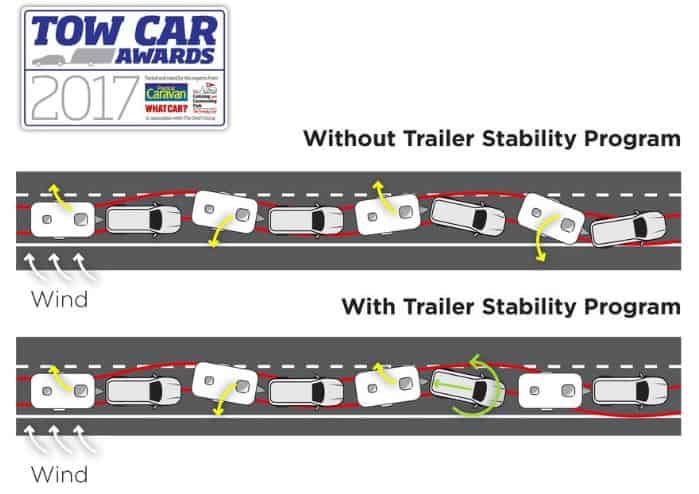
Now, as you should note in the video, the ATC system will not instantly engage the breaks under some light snaking.
You wouldn’t want it to either. Otherwise, every small pothole or light gust of wind and the caravan breaks would be constantly applied.
I imagine the system works on a gyroscope, even most smartphones today include a gyroscope.
AL-KO ATC Retro Fit
If your caravan doesn’t come with the AL-KO ATC stabilisation system fitted, you can have it retrofitted.
This video below from Practical Caravan goes through the installation, adjustment and testing process for the ATC system.
Alternatives To The AL-KO ATC System
You may own a caravan that isn’t based on the AL-KO chassis but a BPW chassis.
They produce their own product with features similar to the ATC system known as iDC (Intelligent Drive Control). Quite a few Elddis caravans feature the BPW chassis along with iDC.
Active Caravan Stabilisation Conclusions
There have been reports of ATC and similar system systems failing to operate correctly. Apparently, one of the issues can be poor quality 12V wiring between the car and caravan.
Therefore, its recommended that 12V wiring is rated for a 20 Amp load. Active caravan stabilisation systems can be expensive retrofit, but when purchasing a new or used caravan, its a nice additional safety feature to have.
Conclusions On Caravan Stabilisers
However old or new your caravan is, I believe its important to have some form of stabiliser fitted. For it to work effectively, you also need to make sure its properly maintained (friction pad replacement).
Many modern cars have electronic towing assistance features built into the car to correct for sway/snaking.
Its also desirable to source a new or used caravan with the ATC system or similar for additional protection. However, all manual and active stabilisation systems are fallback plans in an emergency situation.
They should not be seen as a reason to avoid loading your caravan properly with good balance and weight distribution.
You also need to make sure your caravan is at least as heavy as your caravan, even if you cannot meet the 85% rule (which isn’t a rule, its guidance).
I hope you learnt something new about how a caravan stabiliser works through this post. I also hope you consider coming to see us here at Horton Common and experience our serviced pitches. 🙂
FAQ
A caravan that has an incorrect noseweight or poor weight distribution can cause a caravan to snake. However, there are also external factors that can cause a caravan to snake. For instance, hitting a pothole or a large gust of wind hitting the side of the caravan. The caravan may snake under hard braking, for instance, when trying to avoid an obstacle or another vehicle.
You obviously want to make sure you have some form of caravan stabiliser fitted and your caravan is within weight and loaded properly. However, if your caravan is swaying or snaking, there are means to counter it.
First, don’t panic and don’t start to significantly move the wheel from left to right to try and correct the snaking. Furthermore, don’t try and accelerate out of it or slam on the breaks. Keep a medium grip on the steering wheel straight ahead. Ease off the accelerator and ‘calmly’ wait for the snaking to correct itself.
Want To Visit Horton Common? – Book Here


